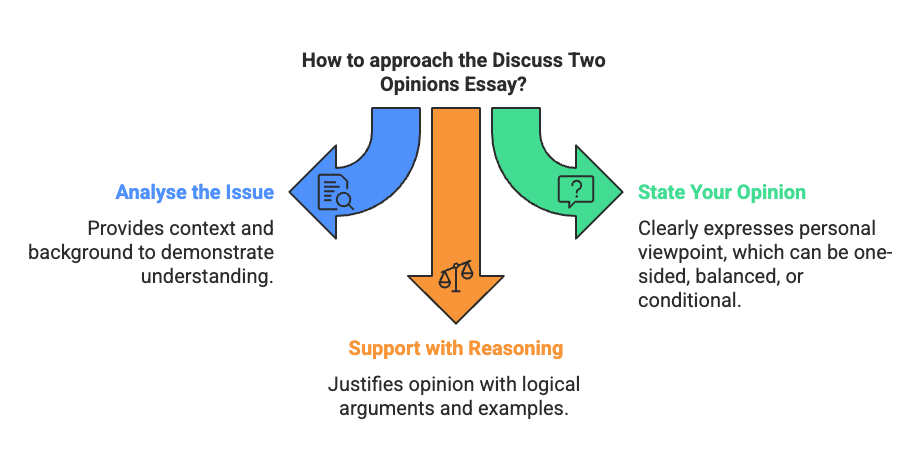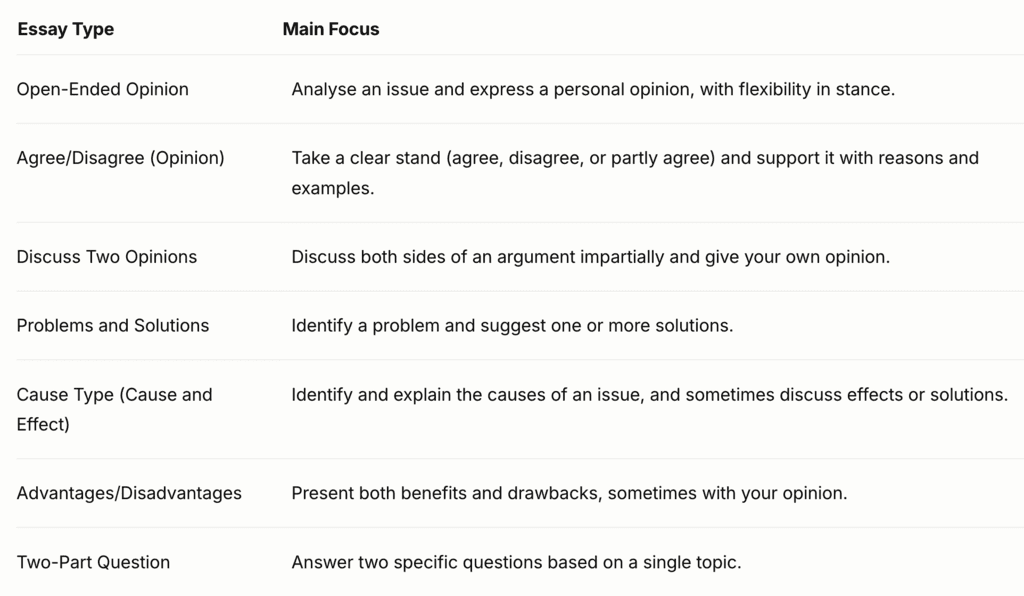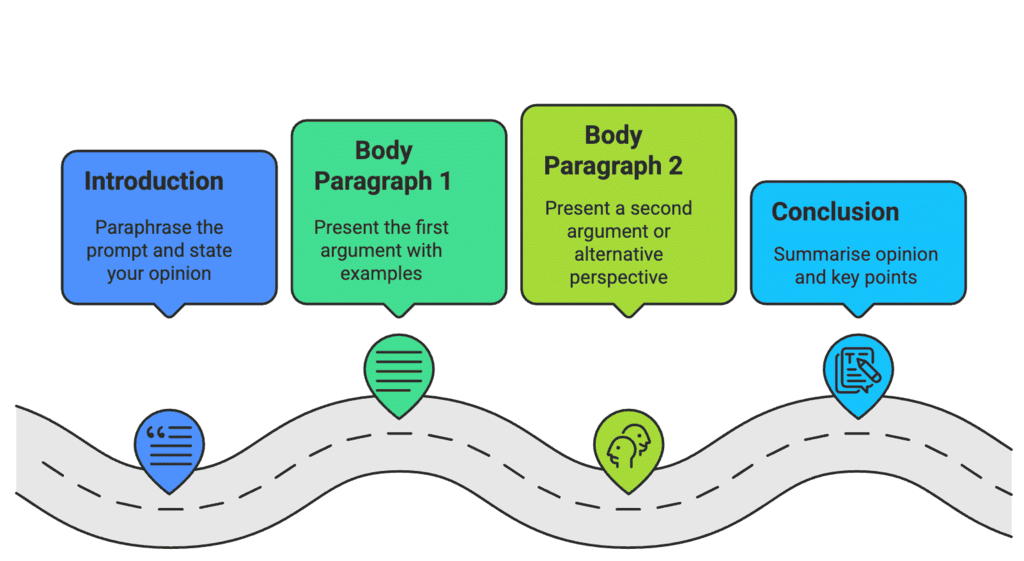How to Write an IELTS Task 2 Essay: Opinion Type | Solved Essays for IELTS PDF Download
- The Open-Ended Opinion Essay is a common question type in IELTS Writing Task 2, often phrased with prompts like “What are your views on this?” or “What is your opinion?”.
- In this essay, you are presented with a statement or issue, and your task is to analyse the topic and express your personal opinion, supported by logical reasoning and relevant examples.
- Unlike Agree/Disagree essays, which require a specific stance (agree, disagree, or partly agree), this essay offers flexibility to present a nuanced or balanced viewpoint.
- You are expected to clearly state your opinion and justify it, ensuring a coherent and well-developed response.
- This essay is assessed not only on grammar and vocabulary but also on how effectively you analyse the issue and defend your perspective.
How to Approach the Open-Ended Opinion Essay?
Analyse the Issue: Discuss the topic or issue, providing context or background to show understanding.
State Your Opinion: Clearly express your personal viewpoint, which can be one-sided, balanced, or conditional, based on your analysis.
Support with Reasoning: Provide logical arguments and examples to justify your opinion, addressing key aspects of the issue.

How Is It Different from Other IELTS Essay Types?
The Open-Ended Opinion Essay differs from other essay types in key ways:

Unlike the Agree/Disagree essay, which requires a defined stance on a statement, or the Discuss Two Opinions essay, which mandates exploring two specific viewpoints, the Open-Ended Opinion Essay allows you to shape your response based on your interpretation of the issue, offering flexibility to present a one-sided, balanced, or conditional opinion.
What to Keep in Mind When Writing This Type of Essay
Here are key strategies and points to remember:
1. Clarify Your Opinion
Decide on your viewpoint, which can be strongly in favor, balanced (acknowledging multiple perspectives), or conditional (e.g., “it depends”).
State your opinion clearly in the introduction and maintain or refine it throughout.
2. Avoid Vague Responses
Do not provide a neutral or overly general opinion without analysis (e.g., “It has good and bad sides”).
The examiner expects a well-developed viewpoint with specific arguments.
3. Use a Logical Structure
A typical structure includes:
Introduction: Paraphrase the prompt, provide brief context, and state your opinion.
Body Paragraph 1: Present your first argument or perspective supporting your opinion, with examples.
Body Paragraph 2: Present a second argument or an alternative perspective (if balanced), with examples.
Conclusion: Summarise your opinion and key points, reinforcing your stance.

4. Support Your Opinion
Use logical reasoning, real-world examples, or evidence to justify your viewpoint.
Address key aspects of the issue to demonstrate understanding and avoid superficial points.
5. Stay Formal and Academic
Use formal language, avoiding contractions (e.g., “do not” instead of “don’t”) and slang.
Employ linking words like “furthermore,” “however,” “for instance,” “in my view,” and “in conclusion” to ensure smooth transitions.
6. Time Management
Spend 5 minutes planning, 30-35 minutes writing, and 5 minutes reviewing.
Ensure your essay is at least 250 words.
What the Question Looks Like
Here are typical Open-Ended Opinion Essay prompts:
Some people believe that modern technology has changed the way we communicate. What are your views on this?
Many countries are investing heavily in space exploration. What is your opinion on this trend?
Urbanisation is increasing rapidly in many parts of the world. What are your views on its impact?
What the Examiner Expects
You are expected to:
Clearly state and develop your opinion on the issue, with logical reasoning and examples.
Analyse the topic to show understanding, addressing its key aspects or implications.
Write at least 250 words in a formal, academic style.
Use effective paragraphing, linking devices, and a range of vocabulary and grammar.
Recommended Structure
Here’s a simple and effective 4-paragraph structure:
1. Introduction (40-50 words)
Paraphrase the prompt to introduce the issue.
Provide brief context and state your opinion clearly.
Example:
Modern technology has significantly altered communication methods globally. In my view, while it enhances connectivity and efficiency, it also poses challenges to personal interactions. This essay will explore these impacts to explain my perspective.
2. Body Paragraph 1 - First Argument Supporting Your Opinion (90-110 words)
Start with a clear topic sentence presenting your first argument or perspective.
Explain the argument in detail, showing its relevance to the issue.
Add a relevant example or evidence.
Example:
One significant benefit of technology in communication is its ability to connect people instantly across distances. Platforms like email and video conferencing enable seamless interaction for work and personal relationships. For instance, remote workers use tools like Zoom to collaborate globally, saving time and costs. This efficiency strengthens professional and social ties, demonstrating technology’s transformative power in communication.
3. Body Paragraph 2 - Second Argument or Alternative Perspective (90-110 words)
Present a second argument supporting your opinion or an alternative perspective (if balanced).
Explain and develop it with reasoning.
Include an example or illustration.
Example:
However, technology can diminish the quality of personal interactions, a notable drawback. Overreliance on digital communication, such as texting or social media, often reduces face-to-face engagement, weakening emotional connections. For example, studies indicate that excessive smartphone use among teenagers correlates with reduced social skills, highlighting the need for balanced technology use. In my view, this challenge underscores the importance of maintaining personal interactions.
4. Conclusion (30-40 words)
Summarise your opinion and key arguments.
Reinforce your stance, avoiding new ideas.
Example:
In conclusion, modern technology enhances communication by improving connectivity, but it risks reducing personal interactions. In my opinion, its benefits outweigh the drawbacks, provided individuals prioritize face-to-face engagement to maintain meaningful relationships.
Tips to Score High
Clarify Your Stance: Present a clear opinion, whether one-sided, balanced, or conditional, and support it consistently.
Use Linking Words: Employ phrases like “firstly,” “on the other hand,” “for example,” “in my opinion,” and “to conclude” to enhance coherence.
Avoid Informal Language: Maintain a formal tone, avoiding slang or contractions (e.g., use “cannot” instead of “can’t”).
Plan Before Writing: Spend 3-5 minutes outlining your opinion and arguments to ensure a logical structure.
Stay Within the Word Limit: Aim for 260-280 words to meet the minimum 250-word requirement without overwriting.
By following this structure and these tips, you can effectively address the Open-Ended Opinion Essay, meeting the IELTS examiner’s expectations for a well-analysed, clearly structured response with a reasoned personal viewpoint and robust examples.
|
16 videos|30 docs
|
FAQs on How to Write an IELTS Task 2 Essay: Opinion Type - Solved Essays for IELTS
| 1. What is the main difference between an open-ended opinion essay and other IELTS essay types? |  |
| 2. What should I keep in mind while writing an open-ended opinion essay for the IELTS? |  |
| 3. What does a typical open-ended opinion essay question look like on the IELTS exam? |  |
| 4. What does the examiner expect from my open-ended opinion essay? |  |
| 5. What is a recommended structure for an open-ended opinion essay? |  |















